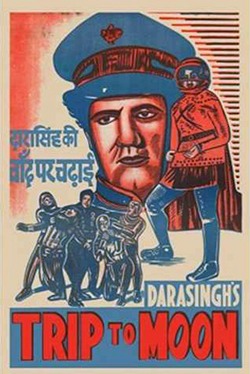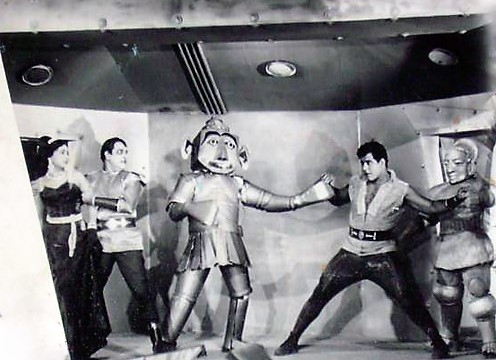 In acknowledgment of the India’s August 23, 2023 moon landing, here’s a look back at TRIP TO MOON/Chand Par Chadayee, a 1967 Indian made dramatization of just what the title promises. I think it goes without saying that in this instance reality and fiction don’t quite match up.
In acknowledgment of the India’s August 23, 2023 moon landing, here’s a look back at TRIP TO MOON/Chand Par Chadayee, a 1967 Indian made dramatization of just what the title promises. I think it goes without saying that in this instance reality and fiction don’t quite match up.
This Hindi language film followed the Tamil KALAI ARASI (1963), which is often credited as India’s first science fiction film, and the Hindi-Urdu WAHAN KE LOG (1967). Taken together the three films impart a style and outlook that essentially defined 20th Century Indian sci-fi, the word for which is archaic, with black and white photography and art direction that appear straight out of the FLASH GORDON serials of the 1930s—and, for that matter, Georges Melies‘ even more ancient A TRIP TO THE MOON/Le voyage dans la lune (1902).
TRIP TO MOON (whose screenwriter isn’t credited, although its dialogue writer is) is believed to have been inspired by THE DAY THE EARTH STOOD STILL (1951), THIS ISLAND EARTH (1955) and FORBIDDEN PLANET (1956), although a more blatant forerunner would appear to be the Egyptian TRIP TO THE MOON/Rehla ilal kamar (1959). In that film a popular Egyptian comedian (Ismail Yassin), together with a much sillier-than-average box robot, traveled to the moon and met scantily clad space babes. TRIP TO MOON features another filmic icon, the Indian pro wrestler and future politician Darasingh (a.k.a. Dara Singh Randhawa), interacting with space babes dressed in what passed for skimpy attire in 1960s Hindi cinema (India having one of the world’s strictest censor boards).
Darasingh plays the burly Captain Anand, who together with his goofy sidekick Bhagu (Master Bhagwan) gets kidnapped by moon-dwelling aliens. It seems that in an Indian lunar settlement the human scientists have been acting up, leading the moon’s inhabitants to preemptively sabotage an upcoming lunar voyage, which just happens to involve Anand and Bhagu. The spaceship they travel in is a roomy contraption packed with flashing lights, operated by moon women who navigate the craft with steering wheels.

The moon turns out to contain large rock-like structures, carved stone steps and vast palaces. It’s peopled by pissy humanoids who give Anand and Bhagu shoe extensions that allow them to walk on the gravity-less surface, and then, following a speedy trial in one of the palaces, imprison them. A&B try to escape by starting a brawl among the guards, the first of several opportunities Darasingh is given to show off his wrestling skills, in tussles he invariably wins (and which invariably involve him removing his shirt).

Anand falls for the fetching Princess Shimoga (G. Ratna). That’s despite the fact that the entirety of the moon’s female populace is extremely interested in Anand, going so far as to engage in gladiator-style combat with each other to win his hand. Another unfortunate fact: the moonlighting king of Mars (Anwar Hussain) also has eyes for the princess. This makes the king even more determined to do in Anand, and spy on him with the help of a scheming Earth woman named Simi (Padma Khanna). Luckily Anand is able to withstand everything the jealous king employs to bring him down, including a mechanical rhinoceros and a supremely goofy robot (correction: a guy in a supremely goofy robot suit).
This being a Bollywood production, you can be sure the proceedings are interspaced with musical numbers that focus disproportionately on the female cast, who are seen twirling, parachuting and dancing in mid-air, with the guys largely sidelined (which is probably for the best). The songs, alas, are quite forgettable.

So too the special effects, which are ludicrously primitive even by 1960s standards; it’s hard to believe that 2001: A SPACE ODYSSEY, and the first manned lunar landing, were only two years away. Yet, intriguingly enough, at least one future movie component is foreseen, as are some real-life technological innovations.
Consider: the climactic tussle between Anand and the king involves clashing electric rods that emit sparks when they touch, not unlike an early iteration of STAR WARS’ lightsabers. In another scene the fax machine is forecast in the form of a box into which one can transmit photos and texts, and in another the King of Mars is contacted via an image that appears in a lens of his spectacles, an early iteration of Google Glass. Overshadowing all this in importance is the depiction of an Indian presence on the moon, which doubtless seemed hopelessly farfetched in 1967 (as exemplified by the technology on display in this film) but is now an unassailable reality.
TRIP TO MOON, for all its ridiculousness, never quite reaches primo bad movie status due to the fact that it’s simply too self-aware. Director T.R. Sundaram seems fully cognizant of the creaky and outmoded nature of the proceedings, and makes no effort to play down those aspects; if anything he, like India’s other science fiction pioneers, enthusiastically leans into them.
Vital Statistics
TRIP TO MOON (Chand Par Chadayee)
NH Studioz
Director: T.R. Sundaram
Screenplay: Balakishan Mouj (dialogue)
Cinematography: K. Krishnaswamy
Editing: G.D. Joshi
Cast: “Darasingh” (Dara Singh Randhawa), Anwar Hussain, Master Bhagwan, C. Ratna, Late S. Nazir, Padma Khanna, Kanchanamala, Rajrani, Helen, Trilok Singh, Saudagar Singh, Mohammad Azad
